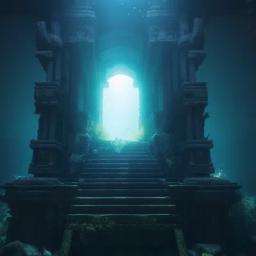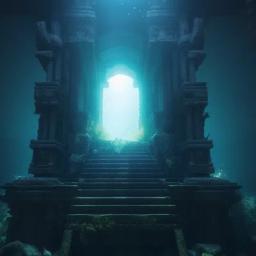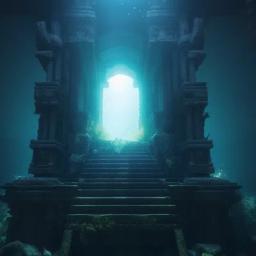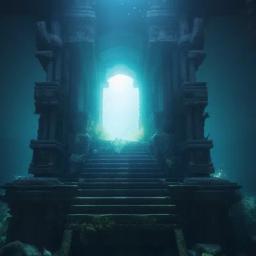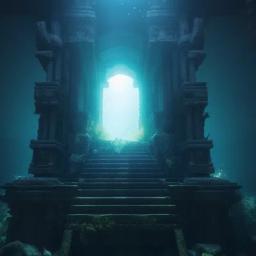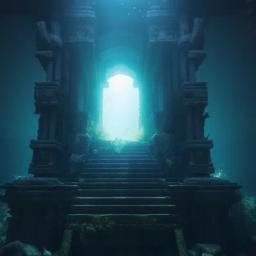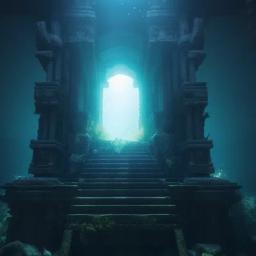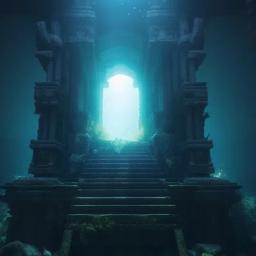In about two hours the boat rested in a paved plaza close to the rocky wall of the valley. On one side I could view the entire city as it sloped from the plaza down to the old river-bank; on the other side, in startling proximity, I was confronted by the richly ornate and perfectly preserved facade of a great building, evidently a temple, hollowed from the solid rock. Of the original workmanship of this titanic thing I can only make conjectures. The facade, of immense magnitude, apparently covers a continuous hollow recess; for its windows are many and widely distributed. In the centre yawns a great open door, reached by an impressive flight of steps, and surrounded by exquisite carvings like the figures of Bacchanals in relief. Foremost of all are the great columns and frieze, both decorated with sculptures of inexpressible beauty; obviously portraying idealised pastoral scenes and processions of priests and priestesses bearing strange ceremonial devices in adoration of a radiant god. The art is of the most phenomenal perfection, largely Hellenic in idea, yet strangely individual. It imparts an impression of terrible antiquity, as though it were the remotest rather than the immediate ancestor of Greek art. Nor can I doubt that every detail of this massive product was fashioned from the virgin hillside rock of our planet. It is palpably a part of the valley wall, though how the vast interior was ever excavated I cannot imagine. Perhaps a cavern or series of caverns furnished the nucleus. Neither age nor submersion has corroded the pristine grandeur of this awful fane—for fane indeed it must be—and today after thousands of years it rests untarnished and inviolate in the endless night and silence of an ocean chasm.

I cannot reckon the number of hours I spent in gazing at the sunken city with its buildings, arches, statues, and bridges, and the colossal temple with its beauty and mystery. Though I knew that death was near, my curiosity was consuming; and I threw the searchlight’s beam about in eager quest. The shaft of light permitted me to learn many details, but refused to shew anything within the gaping door of the rock-hewn temple; and after a time I turned off the current, conscious of the need of conserving power. The rays were now perceptibly dimmer than they had been during the weeks of drifting. And as if sharpened by the coming deprivation of light, my desire to explore the watery secrets grew. I, a German, should be the first to tread those aeon-forgotten ways!
I produced and examined a deep-sea diving suit of joined metal, and experimented with the portable light and air regenerator. Though I should have trouble in managing the double hatches alone, I believed I could overcome all obstacles with my scientific skill and actually walk about the dead city in person.

On August 16 I effected an exit from the U-29, and laboriously made my way through the ruined and mud-choked streets to the ancient river. I found no skeletons or other human remains, but gleaned a wealth of archaeological lore from sculptures and coins. Of this I cannot now speak save to utter my awe at a culture in the full noon of glory when cave-dwellers roamed Europe and the Nile flowed unwatched to the sea. Others, guided by this manuscript if it shall ever be found, must unfold the mysteries at which I can only hint. I returned to the boat as my electric batteries grew feeble, resolved to explore the rock temple on the following day.
On the 17th, as my impulse to search out the mystery of the temple waxed still more insistent, a great disappointment befell me; for I found that the materials needed to replenish the portable light had perished in the mutiny of those pigs in July. My rage was unbounded, yet my German sense forbade me to venture unprepared into an utterly black interior which might prove the lair of some indescribable marine monster or a labyrinth of passages from whose windings I could never extricate myself. All I could do was to turn on the waning searchlight of the U-29, and with its aid walk up the temple steps and study the exterior carvings. The shaft of light entered the door at an upward angle, and I peered in to see if I could glimpse anything, but all in vain. Not even the roof was visible; and though I took a step or two inside after testing the floor with a staff, I dared not go farther. Moreover, for the first time in my life I experienced the emotion of dread. I began to realise how some of poor Klenze’s moods had arisen, for as the temple drew me more and more, I feared its aqueous abysses with a blind and mounting terror. Returning to the submarine, I turned off the lights and sat thinking in the dark. Electricity must now be saved for emergencies.
Saturday the 18th I spent in total darkness, tormented by thoughts and memories that threatened to overcome my German will. Klenze had gone mad and perished before reaching this sinister remnant of a past unwholesomely remote, and had advised me to go with him. Was, indeed, Fate preserving my reason only to draw me irresistibly to an end more horrible and unthinkable than any man has dreamed of? Clearly, my nerves were sorely taxed, and I must cast off these impressions of weaker men.





